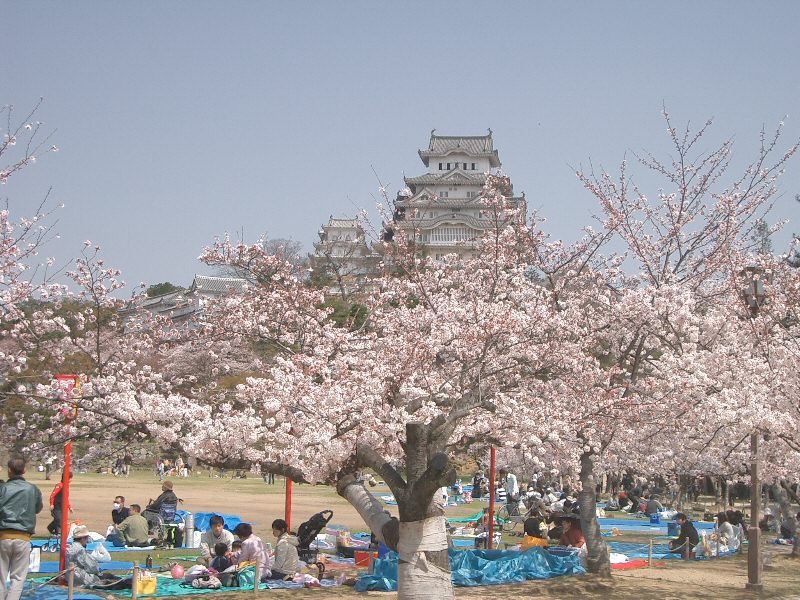
After a long and harsh winter, the cherry blossoms (Japanese: Sakura) are blooming with the rising temperature represent the coming spring. Traces of cherry blossoms can be seen in embankments, parks, streets, schools, and many other places. Events held in parks with many cherry blossom trees, tree-lined avenues, and other flower viewing areas are called “Sakura Festival (Japanese: 桜まつり),” also known as Japan’s Cherry Blossom Festival.
The Cherry Blossom Festival happens from around March 15th to April 15th. As dates depend on the forecast of cherry blossom, it varies from year to year. The content of the event of the festival varies depending on the location. Some will hang lanterns to light the cherry blossom trees at night, which has a different feel from simply viewing cherry blossoms. Some cherry blossom festivals open areas that are usually inaccessible to the public. For example, the Osaka City’s “Crossing Cherry Blossom Road (桜の通り抜け)” at Japan Mint is quite famous, held from April 13th to April 19th, 2022. In addition, there is a cherry blossom festival with live music performances and vendors at the venue. “Sakura Festival (Japanese: 桜まつり)” refers to events held at cherry blossom viewing spots, while “Hanami (Japanese: 花見)” refers to the act of going to see the cherry blossoms.
Japan has had the custom of viewing cherry blossoms since ancient times, but it was not the cherry blossoms that were admired in the earliest days. In the Nara period, about 1,300 years ago, Nara was the capital, and nobles held special events to appreciate the plum blossoms and wrote poems inspired by them, so the first flower viewing activities were “plum blossoms viewing” rather than “sakura viewing”. It was not until the Heian period about 1,200 years ago that the object of appreciation changed from plum blossoms to cherry blossoms.
The noblemen, aristocrats, and emperors of the Heian period would enjoy cherry blossom viewing in the capital of that time, Kyoto. This action was then introduced to the commoners in Tokyo during the Edo period. More and more people enjoyed and fell in love with cherry blossom viewing. As a result, stalls and vendors began to open up shops in cherry blossom viewing spots, which is considered to be the prototype of the cherry blossom festival. As time passed, street lights, lanterns, and other lighting equipment were added, allowing another way of appreciating the beauty of cherry blossoms after nightfall. After 2000 AD, even music performances were incorporated into cherry blossom viewing activities. More shrines and temples were opened for worship and flower viewing at night.
Cherry blossoms have been the representative of spring since the Heian period. They are loved by everyone and become the Floral emblem of Japan. The cherry blossom season is around April, which coincides with the major annual events in Japan. Therefore, it symbolizes the new beginning of life such as admission, graduation, and employment. It is also a symbol of impermanent beauty. There are now more than 600 varieties of cherry blossoms in Japan, of which Somei-yoshino (Japanese: ソメイヨシノ), also known as Yoshino cherry, which spreads to the whole country after the Meiji era, has the largest number (Katsuki, 2015). Cherry blossoms bloom from southern to northern Japan, just like a pink cloud drifting across Japan. The earliest cherry blossom viewing spot is in Okinawa, and the latest is in Hokkaido, which is the coldest and northeast place in Japan.

Photo via Wikimedia Commons
Now, people gather with their families or friends to celebrate the Sakura Festival with picnics and parties. Sometimes, people also wear beautiful kimonos, Japanese traditional clothes. Friends and relatives sit under the cherry blossom trees with blankets, take out the “bento” (lunch box) prepared by themselves in advance, drink champagne or Japanese sake, and chat and laugh with falling petals passing by the breeze from time to time. They even exchange food with people next to them. Some people bring audio equipment and their musical instruments to sing and dance to the music. The cheerful atmosphere allows people to relax, relieve mental pressure, and enhance mutual communication. Japanese enjoy the festival so much that some companies even list cherry blossom viewing as a “designated project” for employees to have “family day” and “friendship day” to spend time with families and friends. Regular cherry blossom viewing will have certain procedures such as a speech from the organizer, while family and friends-style cherry blossom viewing activities are more casual and have no fixed pattern.
Sakura Festival, the biggest event by the Japanese program at CC, will be held at Bemis Great Hall from 2:00 pm to 3:30pm on Saturday, April 30th, 2022.
Author: Esa Chen
References:
- Yashita, K. (2022, March 30). Sakura Matsuri: 10 famous Cherry blossom festivals in Japan (2022): Live Japan Travel Guide. LIVE JAPAN. Retrieved April 9, 2022, from https://livejapan.com/en/article-a0004909/
- Mishima, S. (2020, April 15). Everything to know about Japan’s cherry blossom festivals. TripSavvy. Retrieved April 9, 2022, from https://www.tripsavvy.com/japan-cherry-blossom-festivals-1550069
- Katsuki, T. (2015) Sakura. pp.2-7 pp.156-160 Iwanami Shoten. ISBN 978-4004315346.
- Brooklyn Botanic Garden (2006). Mizue Sawano: The Art of the Cherry Tree. Brooklyn Botanic Garden. p. 12. ISBN 1-889538-25-6.
- Toshio Katsuki. (2015) Sakura. pp.86-95 p.106 pp.166-168 pp.178-182. Iwanami Shoten. ISBN 978-4004315346
- File: Castle Himeji sakura02.jpg. (2021, January 2). Wikimedia Commons, the free media repository. Retrieved 00:56, April 10, 2022, from https://commons.wikimedia.org/w/index.php?title=File:Castle_Himeji_sakura02.jpg&oldid=523326699.
- File: Yoshino cherry ソメイヨシノ 3.jpg. (2021, May 5). Wikimedia Commons, the free media repository. Retrieved 01:05, April 10, 2022, from https://commons.wikimedia.org/w/index.php?title=File:Yoshino_cherry_%E3%82%BD%E3%83%A1%E3%82%A4%E3%83%A8%E3%82%B7%E3%83%8E_3.jpg&oldid=558105071.